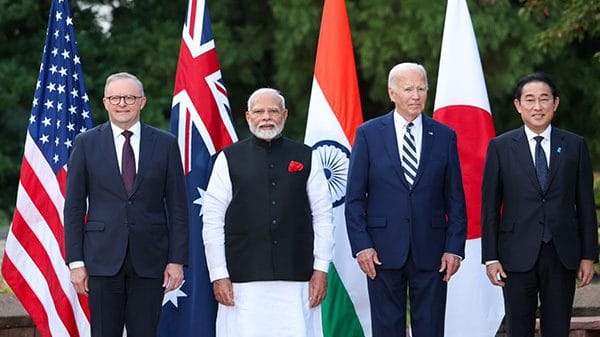Economic diplomacy is a critical tool for building global partnerships, improving domestic prosperity, and increasing the security of supply chains. The Narendra Modi government has prominently featured economic diplomacy in its engagements with the United States, the Quad, and other global partners. Yet, India’s economic linkages in the Indo-Pacific region remain underdeveloped for a nation of its economic heft. An expanded economic engagement effort in the region, including key steps on both trade and investment—particularly outbound investment—could augment India’s widening array of tools for increasing regional influence.
The Lowy Institute, in its 2024 edition of the Asia Power Index, ranks India as the third most powerful nation in the region, up one place from the previous year. But its weakest area in the ranking is its economic relationships, where it ranks 10th out of 27 countries included in the report.
According to the World Bank, India’s trade-to-GDP ratio of 31 percent in 2023 is near the bottom among significant Indo-Pacific economies. This gap is relatively modest compared to Japan, Indonesia, and China, but quite significant compared to Korea (74 percent), Thailand (112 percent), Malaysia (145 percent) and Vietnam (158 percent). While India’s ranking among these economies has remained relatively stable over the last twenty years, its percentage has dropped by a quarter since 2012.
In the twelve months leading up to August 2024, India had a total goods trade with the world of $1.1 trillion—roughly the same level as two years prior. Both imports and exports have remained relatively flat during this period.
Also read: ‘Strategic realism’ with ‘economic pragmatism’ — a former diplomat on ‘creative’ economic diplomacy
Improve investment linkages
India ranks lowest among the sub-categories in the aforementioned Lowy index as a “Primary Foreign Investor” in other markets, where it tied for last among the 27 countries studied. This ranking is based on a nation’s position as the top source of foreign investment into any other country. Looking at India’s per-capita income level, a low ranking is understandable due to domestic growth and requirements. However, India is the world’s fifth-largest economy in real terms and is home to massive conglomerates with global footprints. Improving India’s investment linkages with key Indo-Pacific nations is an underutilised tool for India’s regional diplomacy.
As our team looked at the last twelve months of India’s outbound investment data from the Reserve Bank of India (RBI), we found that only two Asian nations—Singapore and Sri Lanka—are among the top ten investment destinations. The largest investment destinations tend to be rich nations like the United States, the United Kingdom, the United Arab Emirates, and Belgium.
During the Modi government’s first term, the world saw India reverse course on its 23-year period of trade liberalisation. India regularly increased customs duties in its Union Budget, adopted forced localisation measures for manufacturing, and instituted price controls on a range of products, which acted as a de-facto trade barrier. These moves were driven by real domestic issues: a massive goods trade deficit and the need to create low- and medium-skilled jobs.
The Modi government’s second term saw a more nuanced approach to trade. While the aforementioned protections remained, they were not substantially increased. Instead, India largely shifted to subsidising firms to manufacture locally through a range of “Production Linked Incentive (PLI)” programmes in sectors such as white goods, specialty steel, drones, and electronics. The one area where direct trade protections have been expanded is the new “Quality Control Orders (QCOs),” which require third-party verification of compliance with Indian regulations at the place of production. QCOs have been introduced for laptops, toys, electrical products, door fittings, chemicals, and more. However, lacking qualified verifiers in key markets like China, enforcement of these orders will again act as a significant barrier to trade.
Also read: India’s Atmanirbharta push shouldn’t shrink economic diplomacy. ‘It must get bigger’
Set the bar higher
India does have a mild case of “trade deal frenzy,” signing three trade agreements in the last two years with the United Arab Emirates, Australia, and the Swiss-led European Free Trade Association (EFTA). While these agreements are fairly robust in terms of tariff reductions, they are narrow in terms of avoiding other measures like services trade relaxations and investment security to promote deeper economic integration.
To be fair, India’s growing network of trade agreements indicates a higher degree of comfort in making bilateral commitments than either the Trump or Biden administrations here in the United States. But the US is clearly no longer a paragon of trade openness. India’s bar should be set higher.
And, of course, India has avoided being a party to the larger pan-Asia trade agreements, backing out of the Regional Comprehensive Economic Partnership (RCEP) at the last minute, and never attempting to join talks under the Comprehensive and Progressive Agreement for Trans-Pacific Partnership (CPTPP). India is a party to the South Asian Free Trade Area (SAFTA) agreement, but its provisions on market access are limited and have not spurred meaningful changes in regional economic integration.
As a growing economic powerhouse, Asia’s key economies will increasingly expect a higher degree of commercial integration with India. Building these linkages will improve peoples’ well-being in India and in partner nations. And another key result will be in boosting India’s leadership role in the region—an important consideration in a period of regional instability.
The author is the Director of the Chair in US-India Policy Studies at Center for Strategic and International STudies (CSIS). He tweets @RichardRossow. Views are personal.
(Edited by Prashant)







Join RCEP.